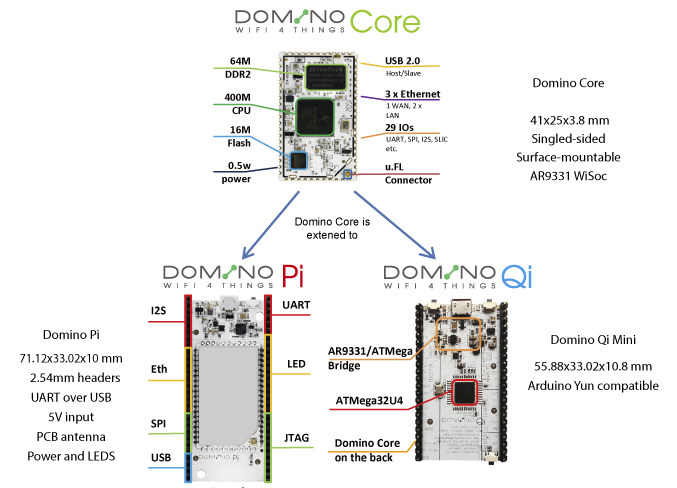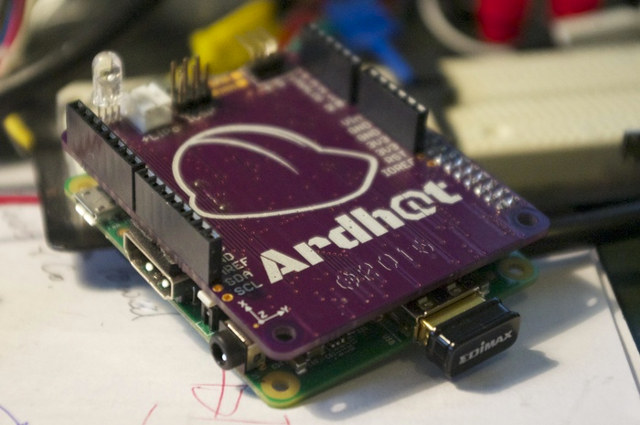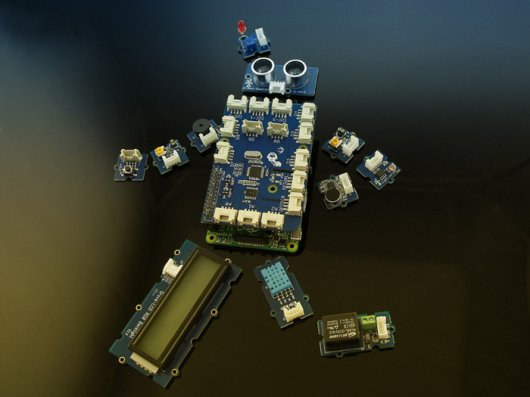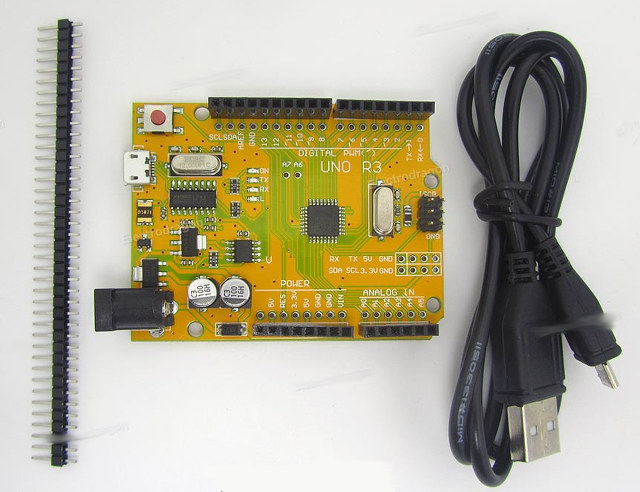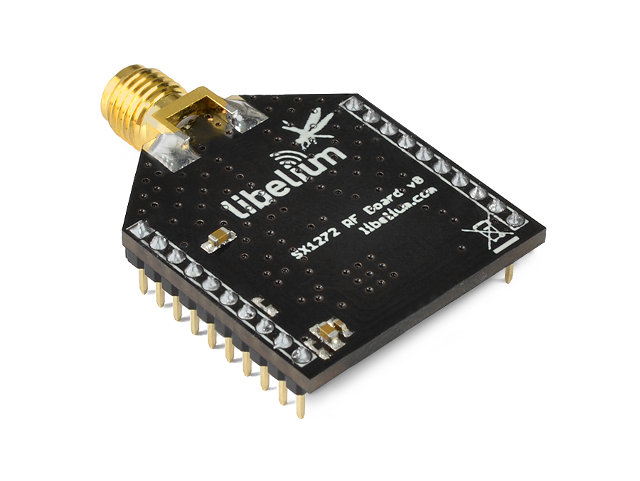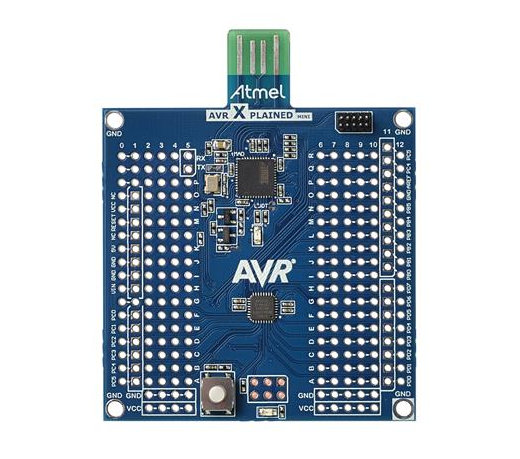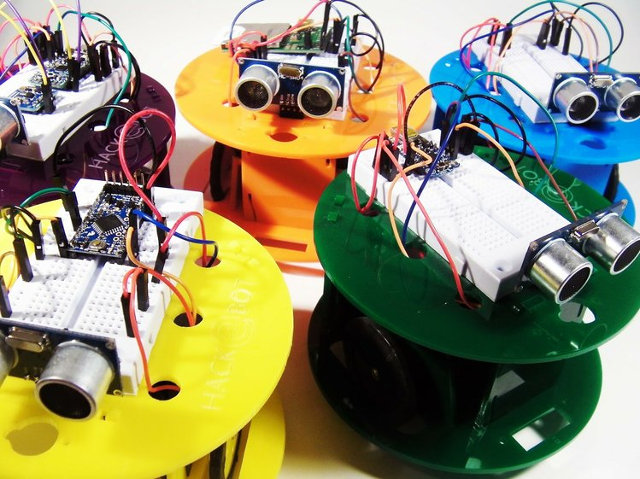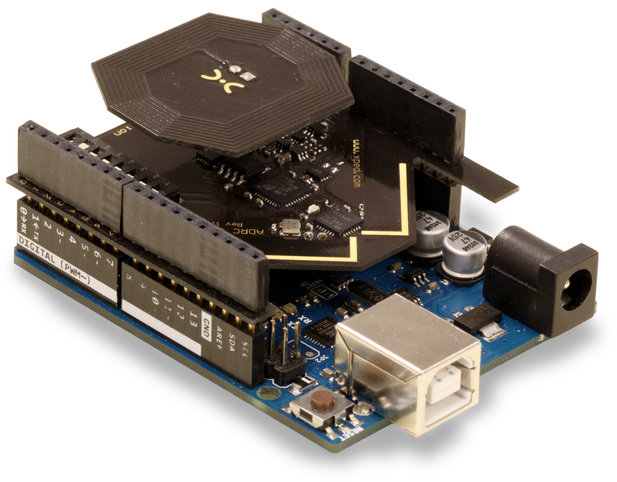The makers of GL.iNet OpenWRT compatible router have decided to build a module and two development boards based on Qualcomm Atheros AR9331 WiSoC. Domino.IO is composed of a Domino Core Wi-Fi module that can be used in your own project, but if also part of Domino Pi, a breadboard-friendly board featuring the module, and Domino Qi mini, a similar board with an Atmel ATMEga32U MCU making it compatible with Arduino Yun board. Domino Core specifications: SoC – Qualcomm Atheros AR9331 MIPS processor @ 400MHz with System Memory – 64MB DDR3 Storage – 16MB flash Connectivity – 802.11 b/g/n Wi-Fi with u.FL connector I/Os via half through holes – USB 2.0 host/slave, 3x Ethernet, 29 IOs including UART, SPI, I2S, SLIC, etc… Dimensions – 41 x 25 x 3.8 mm Domino Pi and Qi mini summarized specifications are shown in the table below. Domino Pi Domino Qi Mini Wi-Fi Module Domino […]
ARDHAT adds Arduino Shield Compatibility, an ISM Band Radio to Raspberry Pi and ODROID-C1 Boards (Crowdfunding)
NinjaBlocks created Pi Crust add-ons board adding a 433MHz radio and Arduino compatibility to the Raspberry Pi Model A & B a few years ago, but the product has since been removed from their store. But a startup called ubIQio has now created a similar product compatible with Raspberry Pi Model A+, B+ and B2, as well as ODROID-C1 which also comes with a 40-pin R-Pi header. The ARDHAT board is a HAT compatible add-on board with an Atmel MCU, Arduino headers, as well as an optional long range mesh ISM radio (433, 868 and 915 MHz) and various sensors. There are four versions of the board: Basic Ardhat, Ardhat-I, and Ardhat-W and Ultra, which share the following specifications: MCU – Atmel MCU @ 16MHz Headers and I/Os Arduino compatible header accepting 5V Arduino shields 12 ch PWM O/P, 6 ch analog I/P Real-time Clock Programmable Power/Navigation combo switch Programmable […]
GrovePi+ Starter Kit Adds Multiple Sensors, Relays, an LCD, a Buzzer… to the Raspberry Pi Boards
Seeed Studio and Dexter Industries has introduced the GrovePi+ Starter Kit for the Raspberry Pi (All models) that includes the GrovePi+ board, and various Grove modules adding sensors, buttons, a buzzer, LEDs and more. GrovePi+ board connects to the GPIO header of the Raspberry Pi, and features several Grove connectors to interface with Groves modules part of the starter kit Grove Light Sensor Module Grove Sound Sensor Module Grove Temperature and Humidity Sensor Module (not the ‘PRO’ version) Grove Button Module Grove Rotary Angle Sensor Module Grove Buzzer Module Grove Relay Module 3x Grove LED Modules (One Red, Green, and Blue LEDS, all replaceable with user LED) Grove Ultrasonic Sensor Module Grove LCD RGB Backlight Module Grove cables, and a GrovePi+ guidebook are also included. The GrovePi+ board is an Arduino compatible board featuring ATMEGA328 microcontroller, and can be programmed with C/C++, Python, and experimental Go and node.js coding is […]
Arduino UNO R3 Clones Now Cost Less than $5
An original Arduino UNO R3 costs about nearly $25, and I remember clones would cost about $10 on Aliexpress, but today I’ve been informed about VISduino, an Arduino UNO R3 clone, with some cost optimizations such as cheaper components and connectors, which sells for just 15.50 CNY (~$2.50 US) on Taobao, and $4.90 on Electrodragon. But double checking on Aliexpress, I could find another popular Arduino UNO R3 clone for $4.58 including shipping, but no USB cable. Both boards cut costs by replacing ATmega16U2 by CH340 USB to serial chip, and replacing the ATMEGA328P-PU MCU (DIP) by an SMT version of the Atmel MCU such as ATMEGA328P-AU (QFP). Other changes on VISduino include: Replaced USB B-type connector by a micro USB port Added extra through holes side-by-side with the Arduino headers for easier debugging. Extra 2×4 pin holes with TX, RX, VCC, GND, and I2C pins You may have to install […]
Semtech LoRa SX1272 RF Module Enables Up to 30 KM Wireless Range for Arduino, Raspberry Pi, Waspmote, and More
Libelium’s Waspmote is a board based on Atmel ATmega1281 MCU that interfaces with over 80 sensors, and various wireless communication modules, and targets professional wireless sensor network applications such as irrigation systems, smart metering, smart cities, smartphone detection, building automation, and so on. They have some professional kits for over 3,000 Euros including training, but a more affordable Starter Kit is also available for 199 Euros on Cooking Hacks. But I’m not going to cover Waspmote in details today. I just mention it because of an article on embedded.com mentioning compatibility with a Libelium / Semtech LoRa SX1272 RF module delivering up to 30km range in ideal conditions (and usually 22+ km range in LOS), and about 2km range in urban settings. I previously featured XBee-PRO 900HP RF Module with a 45km range, so the Semtech module is just another option, and it works not only with Waspmote, but also the […]
Atmel Introduces ATmega PB MCUs and $8.88 ATmega168PB Xplained Mini Evaluation Kit
Atmel has introduced four new MCU to its megaAVR MCU family with ATmega168PB coming first with 16KB Flash, 512 bytes EEPROM and 1KB RAM, as well as ATmega48PB, ATmega88PB and ATmega328PB to be released in Q1 2015. The new MCUs are pretty similar to the existing mega MCU with an AVR core running at 20MHz, a 10-bit ADC, an Analog Comparator, SPI, I2C, USART, etc…, but they also add a unique serial number readable from application code, the ability to wake-up from power-down mode on receipt of data on the USART interface, and improved accuracy for ADC conversion and UART signals. ATmega328PB also offers a QTouch peripheral touch controller, and on-chip debugging. You can evaluated the new MCU thanks to ATmega168PB Xplained Mini evaluation kit which comes with the following key features: On-board debugger with full source-level debugging support in Atmel Studio Auto-ID for board identification in Atmel Studio 6.2 […]
Robotics News – Hack-E-Bot and RiQ Educational Robots, and Maker Club 3D Printed Robots (Pre-Orders / Crowfunding)
I’ve come across several robotic projects this week, so instead of picking one up, or writing a post for each, I’ll summarize the three products into one post. Two of the projects are educational robots based on Arduino, with the sub $50 Hack-E-Bot, or the more advanced RiQ robot, and Maker Club is a company providing the electronics for robotics kit, and you print the plastic parts with your 3D printer. Hack-E-Bot Robot Hack-E-Bot is an affordable open source robot that hopes to encourage children to learn about engineering, electronics, and programming. The robot is powered by Adafruit’s Trinklet Arduino compatible board, connected to a breadboard, and some add-on boards sensors. The basic version comes with a Sonar sensor, but more add-on boards are on the way including bump sensors, a buzzer, colored lights, a claw, a servo scanner, and so on. The project is listed on CrowdSupply, and has […]
Connect Objects Wirelessly, and Create User Interfaces Easily With Xped DeB for Arduino (Crowdfunding)
Xped, an australian startup, has designed an ecosystem comprised of an Arduino shield with NFC and 802.15.4 connectivity, a Raspberry Pi Model B+ based gateway, and DeB browser that generates a user interface in Android, iOS, or Linux based on an XML file stored in an Arduino board. This allows to connect various objects wirelessly, with reduced power consumption thanks to 802.15.4, and to create user interfaces easily with a text file located in your Arduino board. ADRC stands for Auto-Discovery Remote Control, and that’s what Xped ADRC Shield allows thanks to the following hardware specifications: MCU – RM Cortex M3 32-bit microcontroller with 256 KB of FLASH memory. NFC – NDEF Type-2 Tag with bi-directional communications capability. NFP proximity communications technology which is similar to NFC but was developed by Xped to use less than 1,000th of the power and provide faster speeds than NFC. It is mainly used […]


